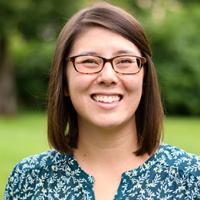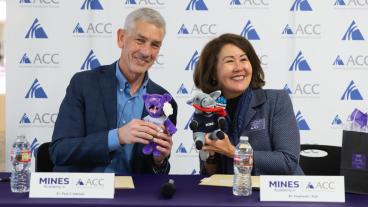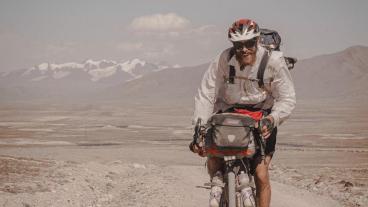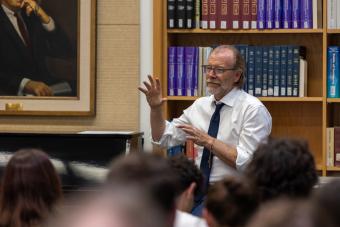
George Saunders '81 answers questions from Mines students, faculty and staff at Arthur Lakes Library – where he worked while studying geophysical engineering at Mines – before his public talk as part of the William H. Erickson Distinguished Lecture Series. (Photos by Leilani Reyes/Colorado School of Mines)
When George Saunders ’81 was a student at Colorado School of Mines, he lived for a time in the Arts and Crafts-style house on Illinois Street that is now home to the University Honors and Scholars Programs.
Long before he became a New York Times-bestselling author and winner of the Booker Prize and National Book Award for Distinguished Contributions to American Letters, he had a student job shelving books at the Arthur Lakes Library.
And the large-scale tapestry hanging on the wall of Friedhoff Hall? It brings back memories of school dances attended there, before, in his own words, he “barely” graduated in 1981 with a bachelor’s degree in geophysical engineering.
Saunders – lauded in TIME Magazine as the "best short story writer in English” – was back on the Mines campus earlier this fall to give a talk as part of the William H. Erickson Distinguished Lecture Series.
In between a campus tour with Mines President Paul C. Johnson and a student and faculty meet-and-greet in his former workplace (AKA the library), he took time to answer five questions from current Mines students and recent graduates about writing, his career and the intersection of art and science.
Editor’s Note: This conversation has been edited and condensed for clarity.
What relationship do you see between your art and your science and vice versa?
(Questions from Tobin Houchin ’25, High Grade editor-in-chief 2022-25)
George Saunders: For a long time, I thought they were separate. When I was here, I thought I almost had to keep writing secret. As I've been doing it longer, I see they're the same thing. They mostly have to do with a journey, from a vague sort of hypothesis type of an idea of a first draft to a more specific embodiment of the story. You go down that path by way of honestly assessing the product.
Whether it's a story or an equation or a bigger geologic project, you're just looking at it very freshly to see, "How am I doing?" and you're adjusting along the way. I know I picked that up here, by flunking many classes and sort of saying, "Well, that didn't work."
So, I think they're the same enterprise, and both of them have to do with trying to seek clarity, as opposed to the confusion that comes when we're thinking more generally or projectively and working through a problem to a very specific statement of it.
Was there an event or realization that encouraged you to go to graduate school for creative writing after an undergraduate degree from Mines?
Saunders: I used my degree at Mines to go overseas and work in the oil business in Sumatra. I was always a writer, really, but I didn't quite know how to do it. There was a moment when I was in Singapore, and I was walking home at night, and there was a construction site. At that time, I was a little bit rigid in my thinking. I didn't really understand that art had to connect with you personally.
So, I'm looking down in the foundation, and I see that there's people in there, and they're moving around. I look a little closer and it was all these quite elderly Malaysian Singaporean women that were hired to clear the rubble every night. I was from a working-class background, and somehow that just clicked for me, that this whole world that we're living in is, in a certain way, a story of economics and class. As somebody said later, "Capitalism can plunder the sensuality of the body." For me, that made me think, oh, yeah, everything is political, and therefore everything is artistic.
That was, for me, a pivot where I thought, “I'm going to do something in addition to engineering.” The writing was always there for me.
What part of your engineering education and background do you believe, if at all, was the most applicable to your early writing career?
(Question from Victoria Filio, first-year student in quantitative biosciences and engineering and member of the Thorson First-Year Honors Program)
Saunders: When I was here at Mines, we had a saying that was, "No partial credit." That was dreadful. If someone said that, that was dreadful. But you could go through the whole proof or the whole problem, and if at the end, you didn't spit out the right answer, you got zero points, which was terrifying.
When I got into writing, it turns out there's no partial credit. You can work on a story for 10 years, 20 years, whatever. It doesn't really matter. Mines really toughened me up to say, “I'm not going to assume that effort equals results.” For a writer, that's gold.
Sometimes in my world, you run into people who are perplexed by the fact that they've worked on something for 10 years, and it's not getting any traction. But here, that was cleared up very quickly. In the 80s, there was a kind of brutal rigor here. It sometimes broke your heart. You just failed. The upside was, you got back up, and you tried again. If after that, you got some success, it was a great lesson in how to how to work through your own issues, to know that if you have a failure, that's just a marker of where you are at that moment. It's not the end of the story. That was really important to me as a writer, because I didn't actually get a first book out until I was 38, so it was a lot, a lot of failure.
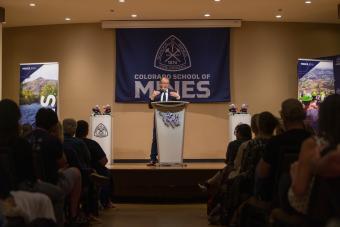
Where do you find the most inspiration for your stories? Do you try to record every story idea that you have?
(Question from Ren Daniels, senior in quantitative biosciences and engineering)
Saunders: I try to not have story ideas, because the problem with that is, if you come up with a story idea, you probably already have an overdetermined idea of where it's headed, and that can be death for a story, because I know the story, and I'm subjecting you to it.
For me, the process is often more looking for a sentence, really, or a joke or something, starting with that, and trying as much as possible to keep the plan out. Don't have a plan, and that way, you're responding organically to what's in front of you. The idea is never “write a big critique of patriarchy.” It's just like, hmm, is there something that would be fun to start with? And then you get out of your own way.
It's like going on a date. If you went on the date and you had a big plan – it's 7 o'clock, we're going to talk about my childhood – you could do it, but it would be a drag. What you have to do is say, “I have good intentions for this date, and my aspiration is to respond to the actual energy of it.” That's more the approach.
For me, the improvisational part of it is really important, because in a sense, this goes back to our science thing. Like a science experiment, a story is made of moments. If there's a moment and the creator has an awareness of what moment they're in, the next moment is response to that.
If it's an honest response, you as a reader are interested. If it's an agenda-laden response – in other words, I'm subjecting you to my plan or my politics or whatever – you pull out a little bit because you feel like you're not involved. The trick is to stay in communication with your audience, which for me, means I might think the story is about this on Thursday. If I read it on Friday and it's giving me a different energy, I have to respond to that. Otherwise, I'm ignoring both the story and my reader.
It's cool, especially to do it for many years. It never gets easier, and it's never anything other than that. Essentially, it's an awareness exercise, and it does potentially translate into the rest of life. That's the essence of art, that communication between reader and writer.
How do you think students can write about difficult nuanced topics, to emphasize their urgency, without making them overwhelming and shutting the conversation down?
(Question from Everett Hegge, junior in mechanical engineering and member of the McBride Honors Program in Public Affairs)
Saunders: The correct teacherly response is, “Yeah, good question. That's it. How do you?” The sub answer is, keeping your reader in mind. So, for example, if I'm writing about something difficult, and I hit you with that in the first three lines, and in rereading, I feel like, oh, God, I want to stop reading it, then you have to do something different. You have to. I think reader awareness is the trick. It's never a lecture. It's always a conversation.
This is the hardest skill to develop, to know where a theoretical reader is. You can't know that, but you can simulate it by asking, “Where would I be if I was reading it?” That's the trick. There's nothing you can't write about, but you might have to jettison some of your plan, and wonderfully, you have to jettison your pre-existing idea about the thing.
For example, if I start to write about my childhood and it's boring, I'm not telling the truth somehow, because my childhood wasn't. It was fun, exciting. A lot of this writing thing is about learning to give up control. It's such an insecure activity, and it's so subjective that we want to have a mantra or a plan or a guidebook. Unfortunately, it's one of those beautiful activities that there's no guidebook except the moment-by-moment progress through it.
Sometimes with my students, they say, “I had a trauma or I had this experience. I want to write about it.” Now you say, “OK, you start there.” Often if a piece of writing is good, it morphs out of its original conception. You might think you're writing about X – if you're doing your job as a reviser of fiction, you find out that actually, yes, you are, but also you're writing about something else. That moment of discovering what the other thing is is what I really live for.
There's a great Chicago writer named Stuart Dybek, and he said the story is always talking to you. You just have to listen to it. Mostly we talk over our stories, but if we can learn to listen to what they want, it takes you into crazy new territory.
Would you say that’s another parallel to science — if you come in with a preconceived answer, you might miss exactly what you’re meant to find?
(Bonus question from Emilie Rusch, Director of Communications at Mines)
Saunders: Exactly. You have a hypothesis, and that's good, you have to, but then when the experiment pushes back on you, the creative thing is say, "Oh, interesting," not "Oh, no," but "Oh, interesting that the world is speaking to me through this experience."
For me, that was a real eureka moment, when in the middle of writing my first book, I realized exactly that, and I recognized it from being here – you can have all the ideas you want about some scientific topic. The world is out there going “No," and you have to adjust.
That's beautiful, because often, very naturally, our self-esteem revolves around how right we are, but we're never right. We're always in the process of finding right. In a certain way, a lifetime of art makes you say, first of all, I'm not any one person. I'm a lot of different people, and I'm always on the path to greater accuracy.

